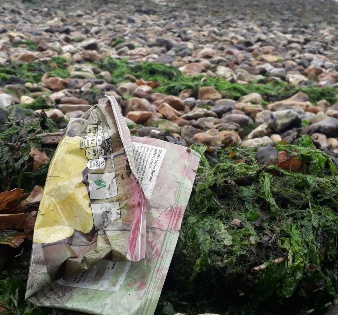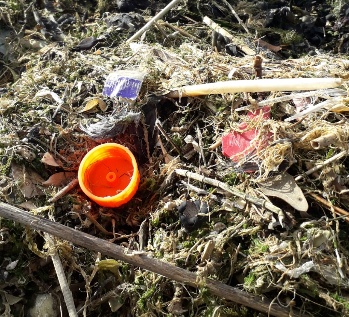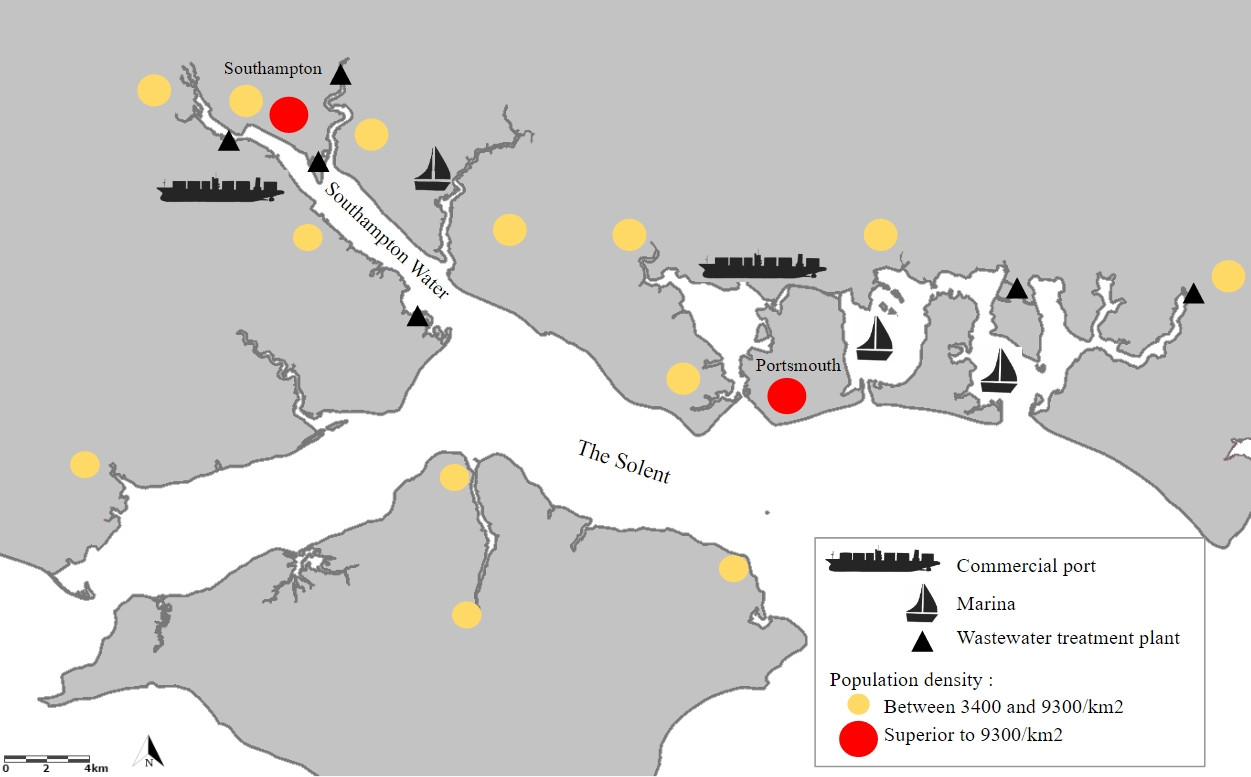
INTRODUCTION
This project aims to provide additional information on the level of microplastics and other anthropogenic debris contamination in the Solent and Southampton Waters.
What are microplastics and anthropogenic debris? Where do they come from?
Microplastics are a type of anthropogenic debris, they are widely defined as particles of plastic smaller than 5mm, and their presence in the oceans can have two origins:
– The fragmentation of large plastic items.
Plastic packaging, if released in the oceans, will degrade under the action of the sun, waves, and other physical and chemical processes, generating microscopic fragments of plastics over time.



Example of plastic litter collected on the eastern coast of Southampton Water
– Products containing or releasing microplastics.
Certain products can shed micro particles of plastic into sewage waters, which will ultimately enter the oceans as microplastics. For instance, washing clothes can release millions of synthetic fibres, which will not be filtered by wastewater treatment plants. As most of them are not equipped with post-filtration systems (which can collect and remove small plastic fragments) microplastics end up released into the environment.
Other anthropogenic debris can include metal, glass, and textile fibers, which can be released in the environment from various sources. However, microplastics will be the main focus of this project, as their persistence and abundance in the environment present numerous dangers.
Why are microplastics dangerous?
Microplastics within sea water can be directly ingested by marine species due to their feeding behaviours. For instance, blue mussels feed on phytoplankton by pumping and filtering water, similarly they can ingest micro particles of plastic. These particles become integrated within body tissues where they can cause adverse impacts, for instance by releasing pollutants, or modifying haemolymph composition, as was demonstrated for the blue mussel M. edulis. Additionally, contaminated individuals eaten by they predators, can partially transfer their load of microplastics. This phenomenon, called “trophic transfer”, is responsible for the transfer of microplastics from the blue mussel, to its predator, the crab Carcinus maenas. These phenomena are likely to expose all marine species to the ingestion, and resultant adverse effects of microplastics.

This figure illustrates a phenomenon called Trophic Transfer, by which species contaminated by microplastics (e.g. the blue mussel M. edulis) can in turn contaminate their predators (e.g. the crab C. maenas).
Microplastics can trigger the formation of unique microbial communities associated with plastic fragments. Multiple concerns have been raised in the scientific community over the interactions between microplastics and human pathogens. As bacteria and viruses could benefit from the abundance of plastic particles for their spreading.
Why use mussels?
Mussels have been extensively used as indicators of marine pollutants in numerous areas of the world. Their use in the context of microplastic quantification in the wild carries multiple advantages. Firstly, the concentration of microplastics in mussel tissue is an indicator of the quantity in the surrounding water. Also, mussels are widely distributed, which means comparisons can be made between surveys worldwide. The impacts of microplastic ingestion on mussel’s vital functions have been extensively studied, and revealed numerous harmful effects. For instance mussel’s filtering capacity and larval development are both impaired by the presence of microplastics. As they are vulnerable to predation, and key ecosystem components, mussels also indicate the level of microplastic exposure to marine species.
The Solent and Southampton Water: areas under pressure.
The Solent is an area prone to microplastic pollution. First, the Solent’s coasts are densely populated which increases the risk of pollution from littering. Additionally, numerous activities such as commercial shipping and leisure boating create pressures on natural habitats, and can be potential contributors to plastic pollution.
Southampton Water receives effluent waters from 8 waste water treatment plants. A study carried out in 2015, which assessed the microplastic concentrations of the Solent estuarine complex; pointed out the abundance of fibres throughout the estuary and their potential origin from sewage and wastewater treatment plants.

Map of the major anthropogenic pressures in the Solent and Southampton Water. Data on population density are approximate (https://parallel.co.uk/3D/population-density/#10.2/53.3886/-1.5501)
The amount of microplastics currently circulating around the Solent and Southampton Water is currently unknown, as well as the exposure for marine species.
Objective of this study: Evaluate the concentration of microplastics and other anthropogenic particles in the mussels of the Solent and Southampton Water
EXPERIMENTS
Before the start of this survey, little information was available on the presence and location of mussel beds in the Solent. Prior to sampling, multiple field trips were carried out in order to locate mussel populations and potential sampling sites. What was observed is that they can be found on a large range of substrates, such as rocks, shingle beaches, and outlet pipes; sometimes in large numbers.




During this project, 63 mussels were collected from 4 sites around the Solent, and processed in the geography lab at Portsmouth University. Blank tests, to validate the experiment, were also run. Unfortunately, the results from site two were not considered valid due to an error that occurred during their processing in the lab.

Map of the sites sampled
Each mussel was measured and weighed. Their flesh was then dissolved in hydrogen peroxide, so that only plastic materials remained. Second, microplastics and anthropogenic particles were separated from other debris (such as sediments) using a highly concentrated saline solution, which caused the plastic particles to float. The upper water layers of each sample were then filtered. The number of particles on each filter was counted using a microscope.
However, due to time constraints, the nature of the particles was not identified through Fourier-Transform Infrared Microspectroscopy (Micro-FT-IR), a device used to confirm the presence and abundance of microplastics as part of the particles collected. Which is why this survey provides an assessment of the abundance of microplastics and other anthropogenic debris in the Solent.
RESULTS
Abundance of particles in the mussels
- Anthropogenic debris were ingested by mussels from all sites. Which indicates that these pollutants contaminate the entirety of the site of study.
- Globally, the concentrations of debris recorded in mussels were equivalent or higher than the ones documented in other locations on the southern English coast, and are characteristic of areas of intense human activity.
- Concentrations of microplastics per gram of mussel were highest in Southampton Water. However, statistically, no significant differences were recorded between results from the different sites.
Types of particles
Size: Mostly, particles recorded were of a small size (between 0.005 and 0.25 mm), which corresponds with other studies, and can be explained by two factors: (1) mussels tend to favour small-sized particles for ingestion, (2) small microplastics are more abundant in the environment due to the processes of fragmentation.
Shape: Fragments represented more than 70% of the particles types recorded. The rest were fibres. This result is in contradiction with a previous survey carried out in Southampton Water, which recorded higher amounts of fibres. Spatial and temporal differences between the two surveys, could explain this discrepancy; as well as mussel’s tendency to select certain types of particles according to their shape. This phenomenon called “selective feeding” is poorly understood in relation to microplastics.
Colour: Black particles were most abundant in all the sites. Other colours sampled include: red, blue, and green.

Pictures of anthropogenic particles recorded during the survey
What are the risks for the Solent?
The Solent harbours a large number of protected areas and wildlife which might be impacted by microplastic pollution. The presence of anthropogenic particles in the mussels, could be transferred to other marine species in the Solent such as the common shore crab (Carcinus maenas), and certain wading birds, which feed on M. edulis. Marine wildlife in general is exposed to the ingestion of microplastics and other anthropogenics particles. The wild population of native oysters (Ostrea edulis), and their surrounding ecosystem, could be affected by the presence of microplastics. Indeed, studies demonstrated that microplastics can impact the composition of species surrounding the oysters O. edulis through a series of knock-on effects, modifying ecological communities. These matters are concerning, and reveal how plastics can have serious impacts on the integrity of the Solent’s natural assets.
Do microplastics accumulate in the Solent and Southampton Water?
Once they reach coastal environments, the dispersion of microplastics is influenced by multiple conditions, such as currents, wind and waves. In Southampton Water, the strong ebb flows exiting the estuary is likely to transport microplastics in the Solent. However, little is known on the circulation of microplastics in the Solent, and the potential areas of accumulation. More research is needed to answer questions relating to microplastic sources, pathways and potential impacts on marine species in the Solent and Southampton Water.









